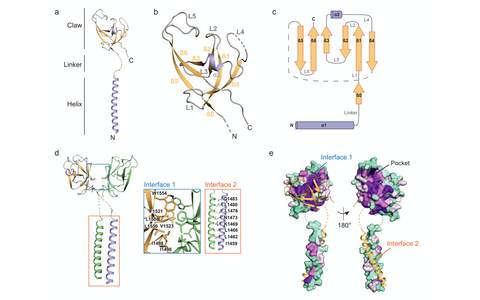
Daumke Lab
Structural Biology of Membrane-Associated Processes
Molecular mechanisms of autophagy
During autophagic degradation, ubiquitinated, misfolded cargo is recognized by the autophagic cargo receptor p62 which facilitates condensation of the cargo. How these condensates are subsequently shuttled to the core autophagy machinery has remained unclear.
Figure 1: Structure of the Claw domain (pdb 6GMA). a-c) The C-terminus of FIP200 contains an OB-like domain that we designated the ‘Claw’. d-e) The claw and adjacent coiled coil formed a dimer in the crystals via a highly conserved interface.
Our collaboration partner Sascha Martens showed that a disordered region of p62 interacts with the C-terminal region of FIP200, which is part of the core autophagic machinery. Subsequently, my group determined the crystal structure of this region, which features a dimeric globular domain with an oligonucleotide/oligosaccharide binding fold (Turco et al., Mol Cell, 2019) (Fig. 1). Owing to its shape, we referred to this domain as the "Claw". Using a structure-function approach, we showed that the interaction of p62 with FIP200 is mediated by a positively charged pocket in the Claw. Consequently, the interaction was enhanced by p62 phosphorylation. Importantly, we showed that the p62-FIP200 interaction promotes the degradation of ubiquitinated cargo by autophagy. In this way, our study has elucidated the molecular basis for a crosstalk between cargo condensation and autophagosome formation, therefore determining the molecular basis of p62 function as an autophagic cargo adaptor.
Publications
- Turco, E., Witt, M., Abert, C., Bock-Bierbaum, T., Su, M.Y., Trapannone, R., Sztacho, M., Danieli, A., Shi, X., Zaffagnini, G., et al. (2019). FIP200 Claw Domain Binding to p62 Promotes Autophagosome Formation at Ubiquitin Condensates. Mol Cell 74, 330-346.e311. https://doi.org/10.1016/j.molcel.2019.01.035.
Researchers in my group
Kryštof Knapp
Tobias Bock-Bierbaum (PostDoc)
Marie Witt (Doctoral student 2014 – 2018)
Main collaboration
Sascha Martens, Max-Perutz Laboratories, Vienna
Press release


